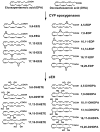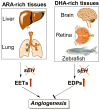Stabilized epoxygenated fatty acids regulate inflammation, pain, angiogenesis and cancer
- PMID: 24345640
- PMCID: PMC3914417
- DOI: 10.1016/j.plipres.2013.11.003
Stabilized epoxygenated fatty acids regulate inflammation, pain, angiogenesis and cancer
Abstract
Epoxygenated fatty acids (EpFAs), which are lipid mediators produced by cytochrome P450 epoxygenases from polyunsaturated fatty acids, are important signaling molecules known to regulate various biological processes including inflammation, pain and angiogenesis. The EpFAs are further metabolized by soluble epoxide hydrolase (sEH) to form fatty acid diols which are usually less-active. Pharmacological inhibitors of sEH that stabilize endogenous EpFAs are being considered for human clinical uses. Here we review the biology of ω-3 and ω-6 EpFAs on inflammation, pain, angiogenesis and tumorigenesis.
Keywords: Cytochrome P450 epoxygenase; Epoxydocosapentaenoic acids; Epoxyeicosatrienoic acids; Soluble epoxide hydrolase.
Copyright © 2013 Elsevier Ltd. All rights reserved.
Figures



Similar articles
-
Soluble epoxide hydrolase as a therapeutic target for pain, inflammatory and neurodegenerative diseases.Pharmacol Ther. 2017 Dec;180:62-76. doi: 10.1016/j.pharmthera.2017.06.006. Epub 2017 Jun 19. Pharmacol Ther. 2017. PMID: 28642117 Free PMC article. Review.
-
Relative Importance of Soluble and Microsomal Epoxide Hydrolases for the Hydrolysis of Epoxy-Fatty Acids in Human Tissues.Int J Mol Sci. 2021 May 8;22(9):4993. doi: 10.3390/ijms22094993. Int J Mol Sci. 2021. PMID: 34066758 Free PMC article.
-
Modulation of mitochondrial dysfunction and endoplasmic reticulum stress are key mechanisms for the wide-ranging actions of epoxy fatty acids and soluble epoxide hydrolase inhibitors.Prostaglandins Other Lipid Mediat. 2017 Nov;133:68-78. doi: 10.1016/j.prostaglandins.2017.08.003. Epub 2017 Aug 25. Prostaglandins Other Lipid Mediat. 2017. PMID: 28847566 Free PMC article. Review.
-
Cytochrome P450 derived epoxidized fatty acids as a therapeutic tool against neuroinflammatory diseases.Prostaglandins Other Lipid Mediat. 2020 Apr;147:106385. doi: 10.1016/j.prostaglandins.2019.106385. Epub 2019 Nov 5. Prostaglandins Other Lipid Mediat. 2020. PMID: 31698143 Free PMC article. Review.
-
Enhancing cancer immunotherapy via inhibition of soluble epoxide hydrolase.Proc Natl Acad Sci U S A. 2024 Feb 13;121(7):e2314085121. doi: 10.1073/pnas.2314085121. Epub 2024 Feb 8. Proc Natl Acad Sci U S A. 2024. PMID: 38330013 Free PMC article.
Cited by
-
Analysis of Serum Exosome Metabolites Identifies Potential Biomarkers for Human Hepatocellular Carcinoma.Metabolites. 2024 Aug 20;14(8):462. doi: 10.3390/metabo14080462. Metabolites. 2024. PMID: 39195558 Free PMC article.
-
Quinolinyl-based multitarget-directed ligands with soluble epoxide hydrolase and fatty acid amide hydrolase inhibitory activities: Synthetic studies and pharmacological evaluations.Heliyon. 2024 Jun 1;10(11):e32262. doi: 10.1016/j.heliyon.2024.e32262. eCollection 2024 Jun 15. Heliyon. 2024. PMID: 38912512 Free PMC article.
-
Attenuation of Polycyclic Aromatic Hydrocarbon (PAH)-Induced Carcinogenesis and Tumorigenesis by Omega-3 Fatty Acids in Mice In Vivo.Int J Mol Sci. 2024 Mar 28;25(7):3781. doi: 10.3390/ijms25073781. Int J Mol Sci. 2024. PMID: 38612589 Free PMC article.
-
Regulation of soluble epoxide hydrolase in renal-associated diseases: insights from potential mechanisms to clinical researches.Front Endocrinol (Lausanne). 2024 Feb 15;15:1304547. doi: 10.3389/fendo.2024.1304547. eCollection 2024. Front Endocrinol (Lausanne). 2024. PMID: 38425758 Free PMC article. Review.
-
Cooling inflammation while potentiating immune checkpoint inhibition: Enhancing the benefit-risk ratio of immuno-oncology therapy.Proc Natl Acad Sci U S A. 2024 Feb 27;121(9):e2400431121. doi: 10.1073/pnas.2400431121. Epub 2024 Feb 14. Proc Natl Acad Sci U S A. 2024. PMID: 38354255 Free PMC article. No abstract available.
References
Publication types
MeSH terms
Substances
Grants and funding
LinkOut - more resources
Full Text Sources
Other Literature Sources
Medical


